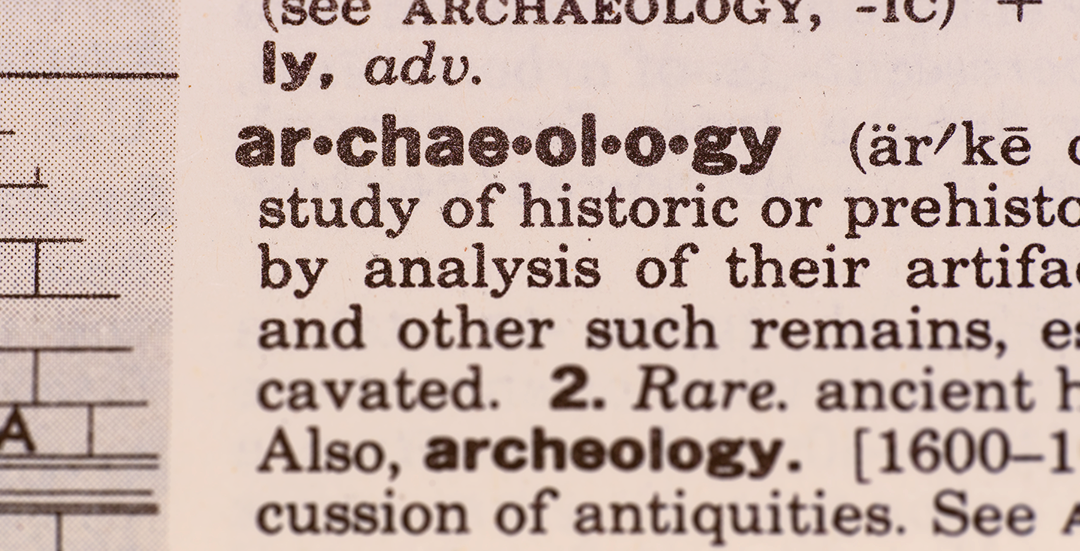A Friend of the Bible

Archaeology comes from two Greek words: archaios, meaning “ancient things,” and logos, meaning “study of.” Archaeology is the study of ancient things. More specifically, it is the study of excavated materials, such as art, architecture, monuments, inscriptions, pottery, literature, items related to language, customs and various other artifacts.
Archaeology is categorized as a science because knowledge is gained through the systematic observation of discovered objects, and these objects are then classified and cataloged into an organized body of information. Archaeology also draws on other sciences such as chemistry, anthropology and zoology.
Archaeology and Historical Context
Broadly speaking, archaeology helps us to better understand the historical context of the Bible, and it also provides background information on subjects about which the Bible tells us little. In many cases, it sheds light on the meaning of certain passages of Scripture. And, of course, it verifies the accuracy and reliability of biblical references to customs, places, names and events.
Numerous scholars have noted the significance of biblical archaeology. For example, biblical scholar Donald J. Wiseman notes that “today, more than 25,000 sites within [Bible lands] and dating to Old Testament times, in their broadest sense, have been located.” These 25,000 sites verify biblical customs, places, names and events.
Nelson Glueck, a specialist in ancient literature, did an exhaustive study and concluded, “No archaeological discovery has ever controverted a biblical reference.” World renowned scholar William F. Albright agrees: “Discovery after discovery has established the accuracy of innumerable details, and has brought increased recognition of the value of the Bible as a source of history.”
Many archaeological discoveries have been made in ancient biblical cities. In biblical times, a city was often built near trade routes and good water supplies. Homes and buildings in these cities were usually made of brick, which could be easily knocked down by an enemy, flood or earthquake.
Whenever this happened, those who lived in the city—or perhaps new inhabitants—would level the rubble and rebuild on top of the old city, using more bricks. Over time, the process would repeat itself again and again. City would be built upon leveled city, on and on throughout history.
As this continued, the city eventually took on the appearance of a mound because it had been built and rebuilt—layer upon layer—many times over the years. Archaeologists call these mounds tells (Arabic for “hill”). These tells could be as high as 75 feet.
Eventually, people might choose to no longer settle there. This might happen, for example, if the water supply dried up, if trade routes changed significantly or if a threatening enemy settled nearby.
When archaeologists study such a mound, they first conduct a surface survey, carefully examining and analyzing pottery and various other artifacts on the surface. They look for clues to the history of the mound, and they look for clues to what may lie beneath the top layer.
They then construct a contour map of the mound and select one or more sectors on the contour map where excavation will begin. They divide the sectors into 10-meter squares so that they can properly catalog whatever is discovered beneath the surface of the mound.
Archaeologists then proceed to excavate one layer at a time, with each layer representing a certain period of occupation. As they go through each successive layer, they steadily uncover the progressive history of the city. The deeper they go, the more ancient history they uncover.
Below, I will give some examples of significant discoveries:
Old Testament Cities and Peoples
Excavations in Ur, Abraham’s hometown, show that it was a powerful city-state before it eventually fell. The fall of Ur may have been one of the reasons that Abraham’s father, Terah, moved to Haran (see Gen. 11:31).
It is interesting to note that critics once considered the Hittites to be pure myth. Some 10,000 clay tablets found in the ruins of an ancient city in Turkey called Boghazkoy now provide abundant archaeological evidence of the existence of the Hittites in Abraham’s time.
Carvings on the wall of an Egyptian temple at Thebes, dated about 1175-1150 B.C., depict the Philistines—enemies of Israel—in all their military might.
The ruins of ancient Babylon have been extensively excavated in modern Iraq. Among the many discoveries is the palace of King Nebuchadnezzar (see Dan. 4:29).
At an archaeological site in the northern part of biblical Jericho, a portion of the lower city wall was discovered that did not fall as it did everywhere else (see Josh. 6:17-25).
False Religions in Old Testament Times
Excavations throughout Egypt have revealed much information about the false gods the Egyptians worshiped at the time of the Exodus. These false gods could not intervene when the true God, Yahweh, inflicted the 10 plagues on the Egyptians. For example, the Egyptian sacred river god Nilus (considered the lifeblood of Egypt) could not prevent Yahweh from turning the Nile into real blood.
Excavators have discovered hundreds of stories about Canaanite gods and goddesses recorded on clay tablets in the ruins of ancient Ugarit (modern Ras Shamra). These tablets provide a virtual mother lode of information about false pagan gods and goddesses, such as Baal.
Language and Writing in Old Testament Times
Evidence continues to mount that the world once had a single language, as Sumerian literature often suggests. A clay tablet discovered bears remarkable similarities to the account of the Tower of Babel in Genesis 11.
Critics once claimed that Moses could not have written the first five books of the Bible because handwriting had not yet been invented. Archaeological discoveries of numerous ancient inscriptions over a wide area of the ancient Near East now conclusively prove that handwriting did exist in the time of Moses.
The discovery of the Rosetta Stone at Rashid, a port on the Mediterranean coast of Egypt, has not only helped scholars decipher the Egyptian writing system (known as hieroglyphics), but has also provided a wealth of information about Egypt’s history, religion and culture.
Ancient Culture in Old Testament Times
Drawings have been discovered in Egypt showing Hebrew slaves making bricks for the cities of Pithom and Ramses.
Laws regulating slavery have been discovered at various archaeological sites—including Nuzi, Sumer, Babylonia, Assyria, and Israel. Such laws demonstrate the Bible’s alignment with the broader Near Eastern cultural view of slavery, while pointing to its more humane treatment in Israel.
The Nuzi Tablets, discovered in Nuzi (east of the Tigris River), are 20,000 burnt clay tablets that contain a wealth of information about customs, stories, and history that shed light on the book of Genesis. Among them are legal tablets indicating that an infertile wife had the prerogative to give her maidservant to her husband in order to provide him with an heir, who could then be adopted by the wife. This sheds light on the biblical account of Abraham and Sarah’s maidservant (see Gen. 16).
Saul’s stronghold at Gibeah has been excavated, and it was discovered that slingshots were among the most common weapons of the day. David used one to slay Goliath (see 1 Sam. 17:49).
Cities in New Testament Times
Nazareth, the hometown of Jesus (see Matt. 2:23; 4:13; Mark 1:9; Luke 1:26-28), has been excavated. Discoveries include olive oil presses and a variety of artifacts from the time of Christ.
Bethsaida, the birthplace of Peter, Andrew, and Philip, has been thoroughly excavated (see Matt. 11:21).
The ruins at Khirbet Qana appear to be the biblical Cana, the town where Jesus turned water into wine (John 2:1-11).
Excavations have uncovered important parts of Damascus, including the remains of a “street called Straight” where Saul once stayed (Acts 9:11).
Excavations in Caesarea have revealed a marketplace, a theater, temples, houses and streets that may have been traversed by the Apostle Peter, who won the Gentile convert Cornelius to Christianity in that city (see Acts 10).
Excavations in Philippi have uncovered a number of shrines to pagan gods and goddesses. The Apostle Paul, of course, wrote a letter to the church at Philippi.
Famous New Testament Personalities
Archaeologists have made a number of discoveries that correspond to well-known biblical figures:
For example, the ruins of Herod the Great’s winter palace have been unearthed in Jericho, the city where Jesus met the tax collector Zacchaeus (Luke 19:1-10).
At the ruins of Caesarea Maritima, archaeologists have discovered a stone tablet bearing the name of Pontius Pilate, who participated in the trial of Jesus (Acts 4:27). The surviving portion bears the actual words, “Pontius Pilate, Prefect of Judea.
The ossuary of Caiaphas, the Jewish high priest who presided over Jesus’ trial, has been discovered (see Matt. 26:57; John 18:13-14). On the ossuary are the words “Caiaphas,” “Joseph, son of Caiaphas.” Inside were the bones of six people, including a 60-year-old (Caiaphas).
A limestone box was discovered that appears to contain the bones of James, Jesus’ half-brother (see Mt. 13:55; Mk. 6:3). It bears the inscription, “James, son of Joseph, brother of Jesus.”
Notable Locations in New Testament Times
A number of prominent New Testament sites have come to light:
Near Mount Gerizim, excavators have uncovered Jacob’s Well, where Jesus spoke to a Samaritan woman (see John 4:1-42).
Archaeologists have uncovered the pool of Bethesda in northeast Jerusalem, where Jesus healed a paralyzed man (John 5:2-11).
An excavation at the Tell Hum site has revealed the ruins of a synagogue in Capernaum, the city where Jesus did much of His public ministry (Matt. 4:13; Mark 2:1).
Archaeologists have unearthed a site in Capernaum that may have been the location of the Apostle Peter’s home (see Mark 1:29).
Part of the Jewish temple of Jesus’ day has been excavated, especially in the area of the southern retaining wall (see Matt. 21; Mark 11).
The Pool of Siloam, mentioned in John 9, has also been discovered. It is 225 feet long and has a three-tiered staircase leading down into the pool.
Conclusion
This article has been deliberately titled “Archae-ology—A Friend of the Bible.” Now you can see why I chose this title. Archaeology truly is a friend of the Bible because it convincingly confirms many people, places and events of biblical times. This constitutes powerful evidence of the reliability of Scripture.
You can trust your Bible!




Leave a Reply